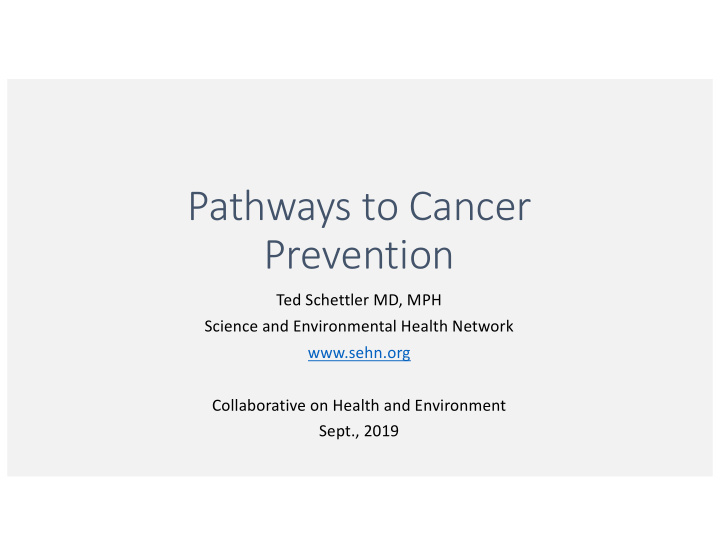



Pathways to Cancer Prevention Ted Schettler MD, MPH Science and Environmental Health Network www.sehn.org Collaborative on Health and Environment Sept., 2019
THE CANCER CONTROL CONTINUUM (NCI) TODAY’S FOCUS Prevention Detection Etiology Diagnosis Treatment Survivorship • Tobacco • Pap/HPV • Environmental • Shared and • Curative • Coping control testing factors informed treatment decision • Health making • Diet • Mammograph • Genetic • Non-curative promotion y factors treatment for survivors • Physical activity • Fecal occult • Gene- • Adherence blood test environment interactions • Sun • Symptom protection • Colonoscopy managemen • Medication t • HPV • Lung cancer vaccine screening • Infectious agents • Limited alcohol use • Health behaviors • Chemo- prevention Adapted from David B. Abrams, Brown University School of Medicine
Etiology: Causes of cancer • More than 100 kinds of cancer; causes vary • What do we mean by “cause”? • Most cancers arise from a collection of multiple factors, not exposure to single agents. Multi-causality. “Causal webs”
Rothman’s Sufficient Causal Model A cause is not a single component, but a minimal set of conditions or events that produces the outcome in an individual person. Interactions among component causes are a primary feature One sufficient causal Central obesity; “pie” for lung cancer inflammation Which causal pathway combinations are sufficient to result in cancer development over time? What are the implications for cancer prevention? “Intercepting” cancer before “sufficiency” is completed?
Sufficient Causal Model • More than one collection of risk factors can cause a particular kind of cancer • Combinations of other component causes can also be sufficient; i.e., various sufficient causes for lung cancer • Tobacco is important but, what else? Proportion of never-smokers among patients with NSCLC increasing 1990-2013. (Pelosof, 2017) Criteria air pollutants; diesel exhaust; dozens of hazardous air pollutants; industrial chemicals, metals; asbestos; silica; radon; radiation; etc. (IARC; Field, Clin Chest Med, 2012) Interactions among causal risk factors, over the life course, make it very difficult to determine valid population attributable fractions for many kinds of cancer
Etiology • A common list of cancer risk factors: Tobacco, diet, obesity, infectious agents, reproductive factors and hormones, ionizing radiation, genetics, alcohol, UV light, pharmaceuticals • What’s missing? Why? • Candidates: • Environmental and workplace chemicals linked to cancer; Chemicals in consumer products • Neighborhood- and community-level variables, including pollutants in air, water, food; some communities have dramatically higher exposures (e.g. St. John the Baptist Parish in La.; communities with cancer risk from air carcinogens 50 X the national average • Non-ionizing radiation (cell phones, etc.)
Key Characteristics of Carcinogens Known human carcinogens have one or more of these properties; These are now routinely integrated into IARC’s assessments of potential carcinogens Smith et al, EHP, 2016
Exposome Exposure to all exogenous environmental agents, socioeconomic conditions, lifestyle, and diet along with markers of endogenous processes across the life-time of an organism or community of interest. (Wild, 2005) Rationale: • To balance the outsized emphasis on the genome with a comparable concept that encompasses the complexity of exposures • To link external exposures to internal body burden, and internal body burden to biologic responses and disease outcomes.
Wild, EMM, 2013
Public health exposome A framework that helps identify and compare differential levels of exposure at critical life stages, personal health outcomes, and their contributions to health disparities at a population level • Includes mediating and moderating factors at both the individual and population health levels. Juarez, Int. J. Environ. Res. Public Health 2014
General external exposures • Chemical • Air, water, soil, food, consumer products • Built environment: home, work, school, community • Social environment • Poverty, education, employment, segregation, discrimination, racism, adverse childhood experiences (ACEs), control in life and on the job, etc. (can directly or indirectly influence risk) • Access to resources and opportunities; measures of resilience • Policy environment: Federal, state, local
Public health exposome conceptual model Juarez et al., 2014
Summary • Unique combinations of exposure, susceptibility, resistance, and life history influence whether or not cancer develops. • It is impossible to know how these components add up to a specific proportion of the total cancer burden. Furthermore, “it is not necessary to propose a hierarchy or play one component cause off against another, fostering competition rather than collaboration”. (Clapp, et al)
Summary An exposome framework: Explicitly acknowledges that multiple, multi-level chemical and non-chemical stressors, over the life course, influence cancer risk in individuals and populations ( a quintessential “mixture” problem) Moves us away from an overwhelming emphasis on individual behavioral change and adds programs and policies that also address workplace, school, community and societal level contributions to risk
Moving from G x E to I x E (Individual, community, societal level variables) McHale; Mutat Res, 2018
Recommend
More recommend